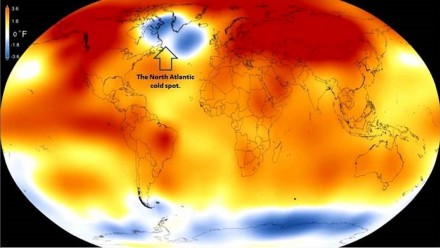Greenhouse gases rising at a rate consistent with mass extinctions
The rate of rise in atmospheric greenhouse gases (GHGs) since the Industrial Revolution is unprecedented in the past 65 million years, according to new research. This has been accompanied by corresponding shifts in average global land and sea temperatures, and could lead to irreversible changes and tipping points for the global climate system, with major negative consequences including mass extinctions of species.
Whilst the earth has experienced much higher atmospheric GHG concentrations in the distant past, it is the speed of the rise that surpasses all geological records (apart from a major asteroid impact).
Before the start of the Industrial Age, the highest recorded additions of CO₂ were less than 0.4 parts per million (ppm) per year, compared with 2-3 ppm per year being added recently. As a result CO₂ levels have grown from approximately 280 ppm in pre-industrial times to 407ppm in 2016.
This increase has caused mean land-ocean global temperatures to rise by approx 0.97°C since 1880.This is lower than projections of 1.36oC consistent with climate sensitivity of 3oC for doubling of CO₂. Further temperature increases would occur had it not been for the solar shielding effects of atmospheric aerosols, which are delaying climate impacts.
As a result, projections of 21st century climate trends suggest that temperatures, ice melt rates and sea levels are lagging behind what would be expected once ice melt rates are equilibrated with rising temperatures and clean air policies reduce the concentration of atmospheric aerosols.
These rises could trigger tipping points in the global climate system, resulting from a synergy of multiple processes, including collapse of the large ice sheets, melting of permafrost, boreal forest dieback and tundra loss, Indian and West African monsoon shifts, Amazon forest dieback, large-scale fires and changes to the El Nino / Southern Ocean circulation and ocean deep water formation patterns.
The changes would be irreversible on the time scale of human civilization and would dramatically change the planet as we know it. They would lead to a continually changing shoreline and increasingly devastating regional climate extremes. Many plants and animals would be unable to adapt with the pace of change, resulting in mass extinctions of up to a third of all species.
Ice melt to date has already contributed to the North Atlantic Cold Spot (see image above) which is changing ocean currents and could herald an abrupt transient cooling of parts of the Northern Hemisphere.
“Cenozoic mean greenhouse gases and temperature changes with reference to the Anthropocene” by Andrew Glikson is published in Global Change Biology. Click here to read the full article.










